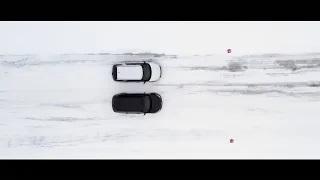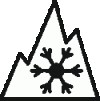On this page
Winter tires
Look for the peaked mountain with snowflake symbol when shopping for winter tires. Tires marked with this symbol meet specific snow traction performance requirements and have been designed specifically for use in severe snow conditions.
At temperatures below 7°C, all-season and summer tires begin to lose elasticity, leading to less traction. Winter tires keep their elasticity and grip at much lower temperatures.
Wide, high-performance tires, other than those specifically designed as winter tires, aren't suitable for snow-covered roads.
As a tire wears, it loses traction. Don't use tires that are worn close to 4 mm (5/32) tread depth on snow covered roads.
Installing winter tires
To help maintain control and stability of your vehicle in icy conditions, you should install winter tires in sets of 4. Vehicle handling will improve when tires with the same type, size, speed rating and load index are installed on all 4 wheels. Don't mix tires with different tread patterns, internal construction, and size as they will make your vehicle less stable.
Put the best tires on the rear of the vehicle to help maintain directional control. This means tires with the deepest tread depth should be installed in the back. If your tires are rotated regularly, they should have similar tread depth.
Make sure that directional tires are installed on the correct side of the vehicle.
Some tires may come with tread-wear indicators that are 2mm. Tires that are worn close to the tread-wear indicators have less traction and shouldn't be used on snow-covered roads or in severe snow conditions. Don't use tires that have less than 4mm tread depth.
Insurance companies may also give you a discount if you use winter tires.
Checking air pressure
Proper air pressure extends tread life, improves safety, and reduces fuel consumption — all vital factors in saving energy and protecting the environment.
Check tire pressure often, especially before any highway driving or before longer trips. Properly inflated, high quality winter tires in good condition will give you best traction on winter roads and increase fuel efficiency.
A tire that has good pressure when checked in a warm garage will be under-inflated when it's below zero outside. Tire pressure goes down in the cold, which is why you should do your checks when the tires are cold. Use the maximum pressure amount shown in the owner's manual or on the doorframe as a guide, but never go above the pressure shown on the tire sidewall. Check your spare tire pressure regularly as well.
You can find the recommended tire pressure and size for your vehicle's tires on the tire information label. This label is usually located on the edge of the driver's door or the door post.

